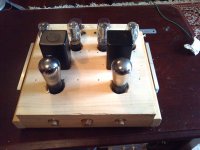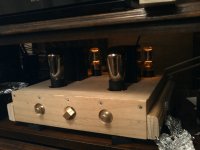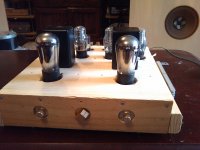Hi!
Your schematic doesn't show values for many components.
I assume for now the B+ filtering is sufficient (there seems to be a huge electrolytic cap in there)
I guess the problem comes from your ground wiring.
chokes in the ground rails can be tricky. If you do so you should connect all grounds to a single point, also the IEC gnd andf chassis.
There is a resistor drawn in the ground connection to the tube stage. this doesn't make sense.
I suggest to first take out the chokes and resistors in the ground rails. See if that solves the problem. If that is sorted out, you can experiment with them.
best regards
Thomas
Your schematic doesn't show values for many components.
I assume for now the B+ filtering is sufficient (there seems to be a huge electrolytic cap in there)
I guess the problem comes from your ground wiring.
chokes in the ground rails can be tricky. If you do so you should connect all grounds to a single point, also the IEC gnd andf chassis.
There is a resistor drawn in the ground connection to the tube stage. this doesn't make sense.
I suggest to first take out the chokes and resistors in the ground rails. See if that solves the problem. If that is sorted out, you can experiment with them.
best regards
Thomas
hi ThomasHi!
Your schematic doesn't show values for many components.
I assume for now the B+ filtering is sufficient (there seems to be a huge electrolytic cap in there)
I guess the problem comes from your ground wiring.
chokes in the ground rails can be tricky. If you do so you should connect all grounds to a single point, also the IEC gnd andf chassis.
There is a resistor drawn in the ground connection to the tube stage. this doesn't make sense.
I suggest to first take out the chokes and resistors in the ground rails. See if that solves the problem. If that is sorted out, you can experiment with them.
best regards
Thomas
first of all. thanks for the pointers
i must draw in a rush. psu: 0.22uf-20H-10uf-10H-100uf-Rdrop-4uf
you saying that if i am using choke in the ground, i should connect the input signal ground to the IEC as well?
ok. ill remove all the ground choke and resistors and get back to you the result
again. thanks alot for the pointer and suggestion. its really appreciated
on the other hand. i am testing this with ta2020. which input signal ground is 2.5Vdc from the psu ground. would this post the problem that the line output transformer secondary oscillate or something? i am using james LOT 10k:600
erwin
Last edited:
Hi Erwin,
No, the other way around, move IEC and chassis to the signal ground. As drawn there will be a AC volatge across the chokes and thus your IEC and chassis will have an AC voltage relative to signal which can induce the hum you are experiencing.
The easiest way to try is to just short the chokes and resistors with a wire. If you get it hum free like this, you can experiment with the chokes in the ground return. They are not necessarily needed
You need to have a clean ground structure throughout the system.
Is the ground of your source really 2.5VDC above your preamp ground, or does it have a 2.5V DC offset in the output ? In any case you need to take care of this and cannot just blindly connect it to your preamp.
BTW, since you are using a step down output transformer, this opens the possibility to use a TVC at the output rather than a resitive pot at the input. This will yield a big sound improvement in my experience
Best regards
Thomas
you saying that if i am using choke in the ground, i should connect the input signal ground to the IEC as well?
No, the other way around, move IEC and chassis to the signal ground. As drawn there will be a AC volatge across the chokes and thus your IEC and chassis will have an AC voltage relative to signal which can induce the hum you are experiencing.
The easiest way to try is to just short the chokes and resistors with a wire. If you get it hum free like this, you can experiment with the chokes in the ground return. They are not necessarily needed
on the other hand. i am testing this with ta2020. which input signal ground is 2.5Vdc from the psu ground.
You need to have a clean ground structure throughout the system.
Is the ground of your source really 2.5VDC above your preamp ground, or does it have a 2.5V DC offset in the output ? In any case you need to take care of this and cannot just blindly connect it to your preamp.
BTW, since you are using a step down output transformer, this opens the possibility to use a TVC at the output rather than a resitive pot at the input. This will yield a big sound improvement in my experience
Best regards
Thomas
hi Thomas
thanks for the pointer.
however the ta2020 is the power amp which the LOT connect to. the power amp input ground is above 2.5v above its psu ground.
good news, i removes the choke and resistors at the ground. it does cuts the hum to 1/3 but its still quiet loud.
before with the choke and resistor on the ground, hum at the output is 15mVac. now with normal ground the hum at output is drop to 5mVac
I tried to disconnect the psu ground from the IEC, but it makes no differences
any more inputs? suggestion that i could try?
thanks alot
erwin
thanks for the pointer.
however the ta2020 is the power amp which the LOT connect to. the power amp input ground is above 2.5v above its psu ground.
good news, i removes the choke and resistors at the ground. it does cuts the hum to 1/3 but its still quiet loud.
before with the choke and resistor on the ground, hum at the output is 15mVac. now with normal ground the hum at output is drop to 5mVac
I tried to disconnect the psu ground from the IEC, but it makes no differences
any more inputs? suggestion that i could try?
thanks alot
erwin
Last edited:
Hi!
I'm glad to read that your hum problem is solved. With the transformer coupled output there should be no problem with intefracing to your amp.
Now you would get the biggest sound improvement if you throw out that resistive pot and put a autoformer volume control on teh output of the preamp.
Best regards ... Thomas
I'm glad to read that your hum problem is solved. With the transformer coupled output there should be no problem with intefracing to your amp.
Now you would get the biggest sound improvement if you throw out that resistive pot and put a autoformer volume control on teh output of the preamp.
Best regards ... Thomas
yeah Thomas
i am very happy. its my second diy tube and my first DHT very happy. All thanks to your help and suggestion
very happy. All thanks to your help and suggestion
yes, i have been wanting to try out TVC, do you have any recommendations?
i am using LDR at the moment tho. which is not bad compare to the normal potentiometer
best regards,
erwin
i am very happy. its my second diy tube and my first DHT
yes, i have been wanting to try out TVC, do you have any recommendations?
i am using LDR at the moment tho. which is not bad compare to the normal potentiometer
best regards,
erwin
Hi!
Dave Slagle's (intactaudio)
Thomas
yes, i have been wanting to try out TVC, do you have any recommendations?
Dave Slagle's (intactaudio)
Thomas
Besides the TVC route, check out the LRD volume control kits. Reputedly they sound as good as TVCs.
[Review] Paul Hynes Design LDR volume control kit review - [English]
DIY "Lightspeed Attenuator" - Passive LDR Volume Control (audio optocouplers)
Lightspeed Attenuator / Audiohm Optocouplers / LDR • DIY Audio Projects Forum
all about volume control...
The above should make a start. Anyone built one?
andy
[Review] Paul Hynes Design LDR volume control kit review - [English]
DIY "Lightspeed Attenuator" - Passive LDR Volume Control (audio optocouplers)
Lightspeed Attenuator / Audiohm Optocouplers / LDR • DIY Audio Projects Forum
all about volume control...
The above should make a start. Anyone built one?
andy
hi Andy
i have built DIY "Lightspeed Attenuator" - Passive LDR Volume Control (audio optocouplers) but with the buffer, it sounds superb. however with buffered its been coloured by some active stage. but it still very nice. its one of best passive preamp imho.
Hi Thomas
i got question about TVC, why we use it on output instead of input of the preamp as the resistive volume pot? so you recon that 10k:600 would be suitable for AVC/TVC?
ps: i still cant differentiate the differences between TVC and AVC. need more research
thanks in advance
regards,
Erwin
i have built DIY "Lightspeed Attenuator" - Passive LDR Volume Control (audio optocouplers) but with the buffer, it sounds superb. however with buffered its been coloured by some active stage. but it still very nice. its one of best passive preamp imho.
Hi Thomas
i got question about TVC, why we use it on output instead of input of the preamp as the resistive volume pot? so you recon that 10k:600 would be suitable for AVC/TVC?
ps: i still cant differentiate the differences between TVC and AVC. need more research
thanks in advance
regards,
Erwin
Hi Erwin,
TVCs need a low source impedance to perform best. If all your sources have low output impedance, you could place it at the input as well. However I found that solid state sources even with low Zout offen sound poor when they are inductively loaded.
TVC stands for transformer volume control. That can be with a separate primary and tapped secondary, or in form of an autoformer which just consists of a single tapped winding. The latter is appreviated AVC for autoformer volume control
Best regards
Thomas
TVCs need a low source impedance to perform best. If all your sources have low output impedance, you could place it at the input as well. However I found that solid state sources even with low Zout offen sound poor when they are inductively loaded.
TVC stands for transformer volume control. That can be with a separate primary and tapped secondary, or in form of an autoformer which just consists of a single tapped winding. The latter is appreviated AVC for autoformer volume control
Best regards
Thomas
G'day All,
Geez this thread has progressed a lot since I finished my 26 pre. I've recently updated my preamp using some Hashimoto Hl-20K transformers. I was using 2 Hammond 150 chokes in series with a FT-3 0.1uF & 1M RC output, for over a year.
The transformer out did bring a lot of improvements to the sound. Clarity is something that stands out the most, I'm not good at using audiophile words but it sounds much more natural now with the Hashimoto's in there. I've been running them in and the bass is also improving. Still not quite as good as the 300H plate choke, but it seems to be getting there in time.
The rests of the system uncludes a 2A3 PP amp and Philips AD5200M in JE labs open baffles, with Saba black cone tweeters. One thing that was also evident, was the sound of guitar. The notes seemed to have more weight to them.
The next stage is to add a TVC and do away with the pot and input cap. I'm using battery grid bias as per schematics in the this thread. I'll post my findings when I get around to this upgrade.
Cheers,
Rich
Geez this thread has progressed a lot since I finished my 26 pre. I've recently updated my preamp using some Hashimoto Hl-20K transformers. I was using 2 Hammond 150 chokes in series with a FT-3 0.1uF & 1M RC output, for over a year.
The transformer out did bring a lot of improvements to the sound. Clarity is something that stands out the most, I'm not good at using audiophile words but it sounds much more natural now with the Hashimoto's in there. I've been running them in and the bass is also improving. Still not quite as good as the 300H plate choke, but it seems to be getting there in time.
The rests of the system uncludes a 2A3 PP amp and Philips AD5200M in JE labs open baffles, with Saba black cone tweeters. One thing that was also evident, was the sound of guitar. The notes seemed to have more weight to them.
The next stage is to add a TVC and do away with the pot and input cap. I'm using battery grid bias as per schematics in the this thread. I'll post my findings when I get around to this upgrade.
Cheers,
Rich
Attachments
Last edited:
you were using exactly what I use - 2 Hammond 150 chokes in series, with a FT-3 0.1uF & 1M RC output. It's not bad isn't it!
I'm going to get some better plate chokes and see what that does. I use filament bias which means no input cap - sounds better too, but needs a choke input and a Rod Coleman supply or equivalent. Hammond do suitable chokes - 159ZA, 300mH, 1A, or 159ZC, 60mH, 2A if you prefer.
The 300H inductance with the two 156C does make the 26 feel very happy!
Andy
I'm going to get some better plate chokes and see what that does. I use filament bias which means no input cap - sounds better too, but needs a choke input and a Rod Coleman supply or equivalent. Hammond do suitable chokes - 159ZA, 300mH, 1A, or 159ZC, 60mH, 2A if you prefer.
The 300H inductance with the two 156C does make the 26 feel very happy!
Andy
Hi Andy,
I've been following your posts in interest. The 2 plate chokes are a very good option and are fairly close to the transformer output. I got the idea from Gary Pimm's 26/56 preamp, I also like his use of VR tubes. It's the best option for the price.
Schematics
I've got Rod's filament supply and still am yet to install it. I was also considering trying filament bias but will need to upgrade the transformers. It's a choke input with locally wound 60mH 2A chokes, with 7V before the regulator.
Could you elaborate a bit more on why you found filament bias better than battery grid bias?
Also, have you used the Hammond 300mH 1A choke in your 26 filament supply?
They were indeed, but I'm happer with 'Japanese steel' in their place.
Rich out
I've been following your posts in interest. The 2 plate chokes are a very good option and are fairly close to the transformer output. I got the idea from Gary Pimm's 26/56 preamp, I also like his use of VR tubes. It's the best option for the price.
Schematics
I've got Rod's filament supply and still am yet to install it. I was also considering trying filament bias but will need to upgrade the transformers. It's a choke input with locally wound 60mH 2A chokes, with 7V before the regulator.
Could you elaborate a bit more on why you found filament bias better than battery grid bias?
Also, have you used the Hammond 300mH 1A choke in your 26 filament supply?
The 300H inductance with the two 156C does make the 26 feel very happy!
They were indeed, but I'm happer with 'Japanese steel' in their place.
Rich out
My filament supply uses 18v secondaries - it's just a 18+18v toroid. I then have a small cap - 220uF - and in my case my chokes are 280mH at 2.7A. Pretty big. Follow that with 30,000uf of caps or so and then Rod's supply.
Sound was just generally better - cleaner and more focussed.
Andy
Sound was just generally better - cleaner and more focussed.
Andy
... also some special Dale power resistor, selected for sound IIRC.My filament supply uses ...
2nd option?
10 Ohms 5% @ 95 Watts WW POWER RESISTOR (4 pcs) | eBay
The above are overkill, but the supplier has various values to make up 10 ohms at about 50 watts.
eBay - The UK's Online Marketplace
The above can be used in series parallel. These were the best sounding resistor types for me. Equivalent types tend to be harder to find or out of stock e.g.
MULTICOMP|MC14655|RESISTOR, 10 OHM 25W | Farnell United Kingdom
MULTICOMP|MC14663|RESISTOR, 10 OHM 50W | Farnell United Kingdom
http://uk.farnell.com/vishay-sfernice/rw20117a100jb15/resistor-ww-72w-5-10r/dp/1141252
I didn't like the alu clad ones and the thick film types were the worst sounding of all. Needs some kind of wirewound.
Andy
The above are overkill, but the supplier has various values to make up 10 ohms at about 50 watts.
eBay - The UK's Online Marketplace
The above can be used in series parallel. These were the best sounding resistor types for me. Equivalent types tend to be harder to find or out of stock e.g.
MULTICOMP|MC14655|RESISTOR, 10 OHM 25W | Farnell United Kingdom
MULTICOMP|MC14663|RESISTOR, 10 OHM 50W | Farnell United Kingdom
http://uk.farnell.com/vishay-sfernice/rw20117a100jb15/resistor-ww-72w-5-10r/dp/1141252
I didn't like the alu clad ones and the thick film types were the worst sounding of all. Needs some kind of wirewound.
Andy
- Home
- Amplifiers
- Tubes / Valves
- #26 pre amp


